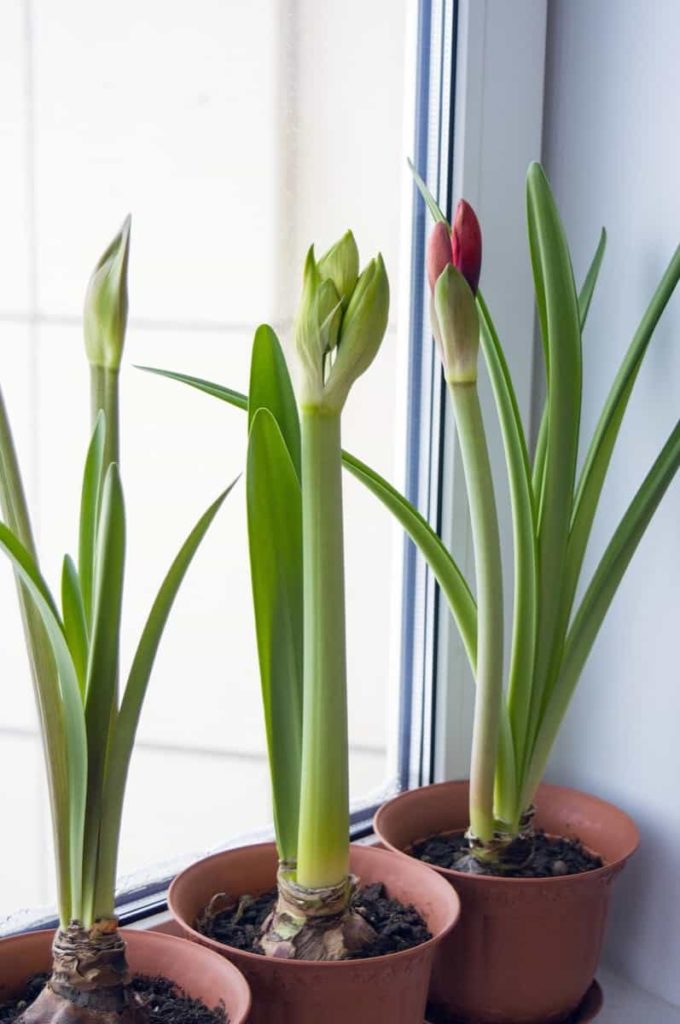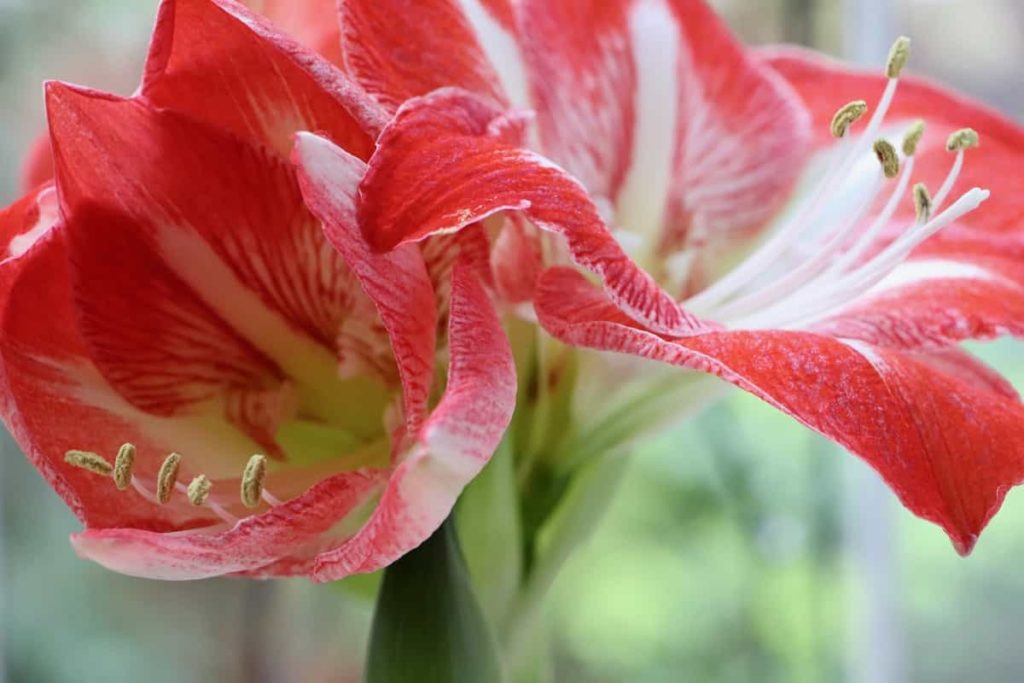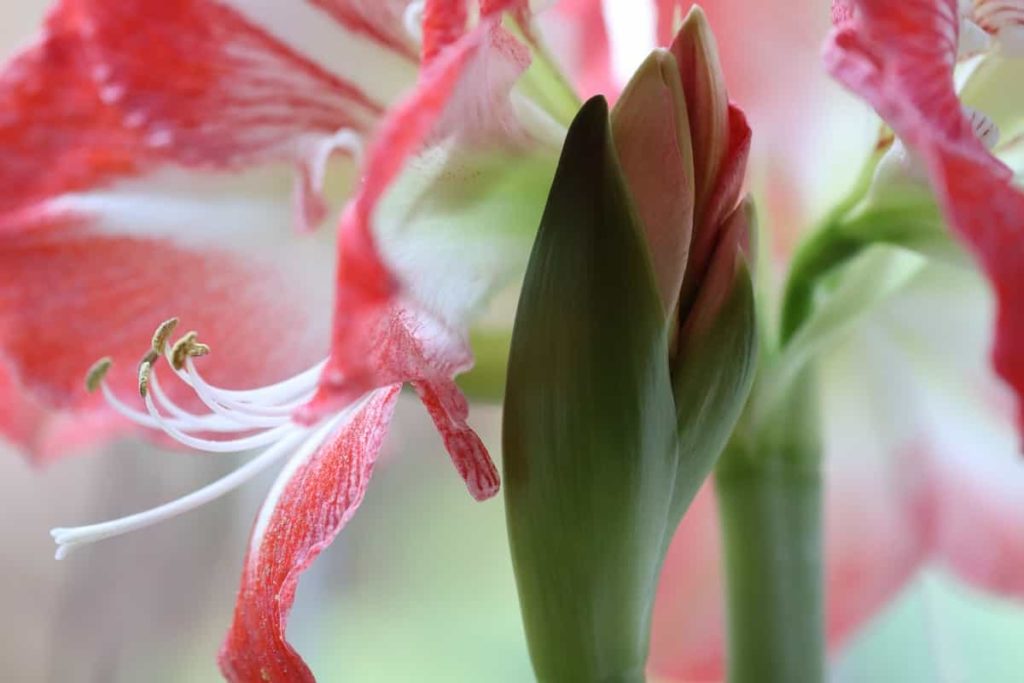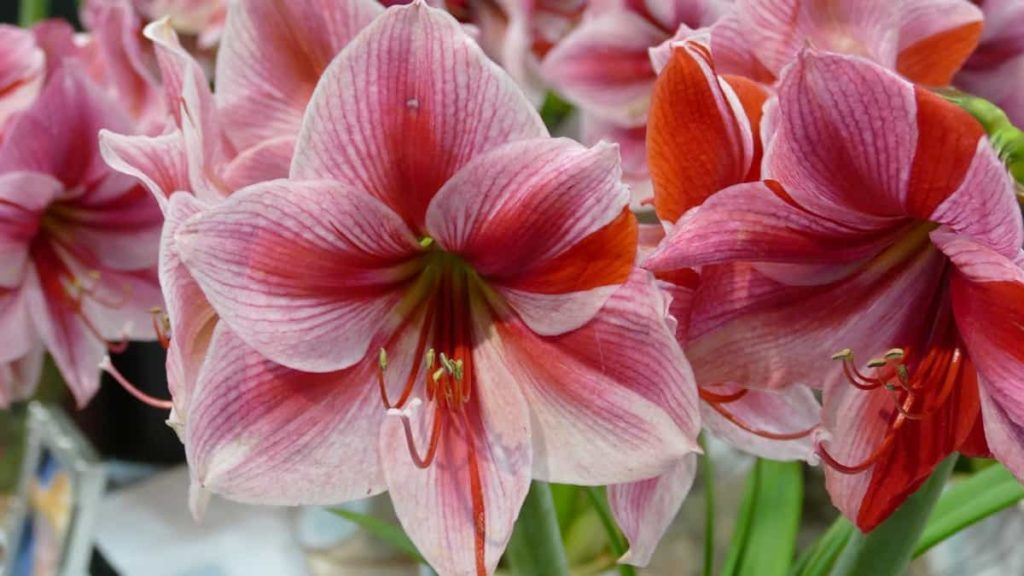Amaryllis plant is grown from bulbs and it produces huge, funnel-shaped flowers in a variety of bright red colors. Each amaryllis bulb will normally produce one or two long flower stalks, each of which can produce up to twelve amaryllis blooms. Let’s check a detailed guide Guide to growing Amaryllis.

Flowers of the amaryllis are native to South Africa, although they are now widely grown in the Netherlands. Amaryllis are grown by gardeners for their dramatic look, and they are frequently used as Christmas centerpieces. Amaryllis bulbs do not need much time to rebloom, and they will bloom all year if planted in a natural environment.
Guide to growing Amaryllis
When to plant Amaryllis plant?
Plant amaryllis outdoors after the final spring frost has passed if you live in a hard frosty area. You may, however, grow it indoors at any time of year. Amaryllis is a South African native that thrives in USDA hardiness zones 9 to 11. It can withstand drought and grows in a mix of full sun and moderate shade.
Selecting of bulbs for growing Amaryllis
Choose the biggest bulbs available for the plant type you want to grow since they will yield more stalks and flowers the first year. The more blossoms a bulb has, the bigger it is. Rotting or damage should not be visible on the bulbs, which should be firm and dry. New growth, such as leaves, can be seen sprouting from bare or planted bulbs.
Choose bulbs with brilliant green fresh growth and no evident damage or stains. An offshoot may sprout from the base of certain bulbs. This will ultimately develop into a new bulb, which you may divide and plant separately.
Planting of Amaryllis bulbs indoors in pots
Amaryllis thrive in small pots. Plastic, metal, ceramic, and terracotta containers are all options. Damage should not be visible on the bulbs, which should be firm and dry. Choose a container with one or more holes on the bottom and easy drainage. Bulb and root rot may be avoided with proper drainage.
In case you miss this: Guide to Growing African Violets from Seeds: Problems, Plant Care

To allow for optimum root development, the diameter of the pot should be around 1 inch larger than the bulb’s broadest point and twice as tall as the bulb. Fill the container with sterile, fresh potting soil rich in organic matter, such as peat moss, until about half full. Place the bulb in the container so that the roots are in contact with the potting soil.
The bulb should extend above the container’s edge. More dirt can be added by tapping it down around the bulb until just one-third to one-half of it is visible. The potting medium should be firm around the bulb. Place the pot in a sink with plenty of room for it to drain and water till the potting soil is completely saturated. Allow for thorough draining. Put the pot near a bright window on a plate or saucer.
Planting of Amaryllis bulbs outdoors in the garden
Amaryllis bulbs have the advantage of being able to be planted straight into the ground. You should plant bulbs in such a way that their necks are a bit above the ground if you don’t experience frost in your location. If you do receive frost, though, you should plant the bulbs about 5 inches deep. On top of that, you’ll want to add 5 inches of mulch.
Once your amaryllis plants begin to produce leaves, you should fertilize them once a month until April. When your plants have finished flowering, remove the stems from your blossoms completely. You may preserve the leaves since they will continue to nurture the bulbs.
Watering for Amaryllis plants
When grown indoors
In general, water the amaryllis pots only if the top inch of the potting mix seems dry to the touch. If you water it more frequently than that, the bulbs may rot. Before watering your plants, move any Spanish moss that is on top of your potting mix to the side. You want to make sure that the water wets the potting mix immediately.
In case you miss this: Guide to Growing Potatoes in Texas: At Home, In Backyard, Containers, In Winter and Summer

When grown outdoors
You may be concerned that your plants may become thirsty, but it is simpler to overwater them than to keep them underwater. Give the bulbs a good soaking once they’ve been planted. The only time you should water the area after that is if the top two inches of soil seem dry to the touch. The months of June and September are an exception. If there are unusually extended dry spells, you should only water your plants.
Sunlight is required for Amaryllis
Amaryllis grows well in a variety of light conditions, including full sun and moderate shade. Brilliant shade creates the ideal environment for outdoor activities. They enjoy early light but brilliant shade in the afternoon when grown as potted plants indoors.
Adequate humidity and temperature for Amaryllis
Amaryllis are tropical plants that thrive in hotter climates. They are hardy to zone 8 outdoors, and zone 7 gardeners can replant them in the garden provided the earth is well mulched.
Pruning of Amaryllis plant
After the blooms have faded, cut the flower stalk back to just above the bulb. Keep watering the plant until it becomes dormant in the fall. You may move the amaryllis outside in the summer and position it in a part-shade location.
In case you miss this: Guide to Growing Cucumbers in California: In Containers, Backyard, Summer, and Winter

Fertilization for Amaryllis plant
During the growing season, feed your amaryllis every two to three weeks with half-strength water-soluble fertilizer. Withhold feeding after flowering to induce the dormancy required to reset the bulbs.
Propagation of Amaryllis plant
Like daffodils, amaryllis bulbs develop side bulbs. Remove the bulbils with care and pot them up to generate additional plants. Allow a few seasons for them to mature before expecting flowers.
Pests and diseases that can harm your Amaryllis plant and their cure
Fellow foliage
The narcissus bulb fly can lay eggs in amaryllis bulbs that have been left outside for the summer. Maggot larvae feed on the bulb’s outer scales and finally find their way into the bulb’s interior. Infested plants’ leaves may get wilted, yellow, and deformed, and the plant may finally die. When squeezed, the bulb’s exterior may look normal, but when pressed, it reveals rotten tissue. Because controlling the narcissus bulb fly is difficult, it is advisable to remove any contaminated bulbs as soon as the narcissus bulb fly is discovered. Insecticides are ineffectual in most cases.
In case you miss this: Guide to Growing Tomatoes in Florida: In Winter, Summer, in Backyard and Containers

Red botch
Red blotch is a fungal disease that can harm amaryllis plants’ beauty as well as their health. However, the plant is typically not killed by this disease. On emerging leaves and at the bottom of flower stalks, red dots or blotches that grow into elongated cankers with crimson borders can appear. Because superficial tiny red or pink patches may grow on the exterior of healthy bulbs, the illness is typically difficult to identify. Underneath these spots, the bulb’s fleshy layers should be white and devoid of marks.
The leaves may grow deformed, and the flower stalks may easily break, resulting in ugly plants. Purchase healthy bulbs to avoid this. Before buying amaryllis bulbs, check them well and avoid those that are broken or have cankers. Plant bulbs in sterile, fresh potting soil in a clean container. Using alcohol, wipe pruners and stakes used on diseased plants. Take appropriate care of your plants. If the illness continues, a systemic fungicide may be used to treat the bulbs.
Care for Amaryllis after blooming
The key to keeping amaryllis plants alive for years is to keep them constantly developing after they have bloomed. Cut the blooms off after they’ve faded to avoid seed production. Seed production depletes vital energy reserves in the bulb, resulting in less flowering. Wait until the flower stem has gone yellow before removing it.
A green stem will continue to encourage photosynthesis, which produces energy that is stored in the bulb for future leaf and blossom growth. If the bulb fails to develop a flowering stalk in the next blooming period, likely, the bulb did not retain enough nutrients during the post-blooming phase. Blooming is encouraged by keeping the plant healthy and expanding.
Place your plant in the sunniest possible area indoors once it has completed flowering. It will keep producing long, silky leaves. Photosynthesis will be aided by these leaves. Continue to water and feed the plant using an all-purpose houseplant fertilizer regularly.
In case you miss this: Merits of Polyhouse Growing: Reasons Explained

Is Amaryllis plant toxic?
Humans and pets should avoid eating amaryllis plants because they are harmful. It includes lycorine, a toxin that causes stomach discomfort, vomiting, and diarrhea. Vomiting, gastrointestinal discomfort, tremors, and depression can occur if amaryllis is consumed by a pet. Consult your veterinarian if your pet has eaten an amaryllis flower.
How to keep your Amaryllis flowers to grow even?
Plants acquire their energy from sunshine, as you may know. As a result, they’ll grow towards the direction where the sun shines the brightest. Your flowers will be uneven if you leave the container alone. If you want your flowers to grow equally, rotate the pots now and then.
Frequently asked questions about Amaryllis
What growing conditions do Amaryllis like?
Amaryllis can thrive in both the sun and the shade, but it prefers to be in the middle, such as partial shade. Too much sunshine might cause leaf burn, while too much shadow will limit flowering.
How often do I need to water my Amaryllis?
Water your amaryllis at least once a week. You should maintain soil to be moist all the time. Turn the pot now and again to keep the stem straight, rather than reaching for the light and becoming top-heavy as it develops.
What do you do with an Amaryllis plant after it blooms?
Clip the blooms off and cut down the stems after the blossoms have faded. Continue to keep the bulb in its container and provide it with regular water and full daylight. Move amaryllis outside after the last frost. The bulbs can either be kept in pots or planted in the ground.
- Gardening Techniques in Planting Vegetables
- Where to Place Indoor Plants in Your Home
- How to Grow Tomatoes Organically at Home: A Comprehensive Guide
- Organic Gardening on a Budget: Low-Cost Methods and Materials
- Gongura Seed Germination and Planting Methods
- Cabbage Seed Germination and Selection
- Broccoli Seed Germination and Selection
- Asparagus Seed Germination and Variety Selection
- Seasonal Flower Gardening: Best Practices for Spring, Summer, Fall, and Winter
- How to Grow Hibiscus from Flower
- Plantation Ideas for Home Decoration: A Beginners Guide
- Flower Garden Designs and Layouts for Beginners
- Planting and Spacing Techniques in Papaya: A Beginner’s Guide
- Growing Gold: Essential Techniques for Planting Pineapples
- How to Make Kalanchoe Plant Bushy: Home Remedies and Solutions
- 11 Reasons Why Your Gardenia is Not Blooming: Home Remedies and Solutions
- Eco Elegance: The Guide to Designing a Drought-Tolerant Landscape
- Gardening on a Slope: Strategies for Hillside Landscaping
- Nourish and Flourish: Top Organic Mulches for Thriving House Plants
- Everything You Want to Know about Indian Mogra Flower: Discover Uses and Growing
- Green Thumb Success: Expert Tips for Cultivating Greenhouse Pumpkins All Year Round
- Maximize Growth & Flavor: The Ultimate Guide to Companion Planting in Herb Gardens
- How to Control Rhododendron Problems Naturally: Home Remedies and Organic Ways to Fix Them
- Natural Magic: The Remarkable Benefits of Cinnamon for Plants
- Best Steps to Revive Dying Tulip with Natural and Organic Treatment
- 10 Reasons Why Your Angel Trumpet is Not Blooming: Remedies and Treatment
- How to Fix Periwinkle Leaf and Flower-Related Problems: Natural Remedies and Solutions
- How to Fix Zinnias Leaf and Flower Problems: Discover Natural and Home Remedies
- Organic Steps to Induce Lemon Tree Flowers: A Comprehensive Guide
- Bloom Booster: Crafting the Perfect Homemade Bougainvillea Fertilizer
- Optimizing Growth: A Guide to Applying NPK Fertilizer for Potted Plants
- 10 Best Homemade Fertilizers for Rubber Plant: DIY Recipes and Application Method
- How to Boost Female Pumpkin Flowers: Effective Steps for More Flowers and High Yields
- Transform Your Indoor Garden: Top Benefits of Pink Salt for Houseplants
- 10 Best Homemade Fertilizers for Peacock Plants (Calathea): Easy DIY Guide
- Unlock Blooms: 9 Reasons Why Your Potted Chrysanthemum is Not Blooming